A) Copulation is a fixed action pattern, and the female flight sound is a sign stimulus that initiates it.
B) The sound from the earphone irritates the male mosquitoes, causing them to attempt to sting it.
C) The reproductive drive is so strong that when males are deprived of females, they will attempt to mate with anything that has even the slightest female characteristic.
D) Through classical conditioning, the male mosquitoes have associated the inappropriate stimulus from the earphone with the normal response of copulation.
Correct Answer

verified
Correct Answer
verified
Multiple Choice
Listed are several examples of types of animal behavior. Choose the letter of the correct term (A-E) that matches each example in the following questions. A. operant conditioning B. classical conditioning C. innate behavior D. imprinting E. altruistic behavior -A mother goat can recognize its own kid by smell.
A) A
B) B
C) C
D) D
Correct Answer

verified
Correct Answer
verified
Multiple Choice
How do altruistic behaviors arise through natural selection?
A) By his/her actions, the altruist increases the likelihood that some of its genes will be passed on to the next generation.
B) The altruist is appreciated by other members of the population because its survivability has been enhanced by virtue of its risky behavior.
C) Animals that perform altruistic acts are allowed by their population to breed more, thereby passing on their behavior genes to future generations.
D) Altruistic behaviors lower stress in populations, which increases the survivability of all the members of the population.
Correct Answer

verified
Correct Answer
verified
Multiple Choice
Use the following figures to answer the question.
A.
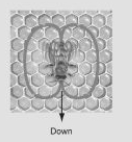 B.
B.
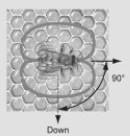 C.
C.
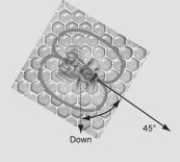 If the figure shows the dances of bees in a hive at noon on June 21 in the northern hemisphere (the sun is directly north of the hive) , which dance is communicating that the food is to the south of the hive?
If the figure shows the dances of bees in a hive at noon on June 21 in the northern hemisphere (the sun is directly north of the hive) , which dance is communicating that the food is to the south of the hive?
A) dance A
B) dance B
C) dance C
D) It is not possible to tell if any of the dances indicate the food is to the south of the hive.
Correct Answer

verified
Correct Answer
verified
Multiple Choice
A stickleback fish will attack a fish model as long as the model has red coloring. What animal behavior idea is manifested by this observation?
A) sign stimulus
B) cognition
C) imprinting
D) classical conditioning
Correct Answer

verified
Correct Answer
verified
Multiple Choice
Use the following figures to answer the question.
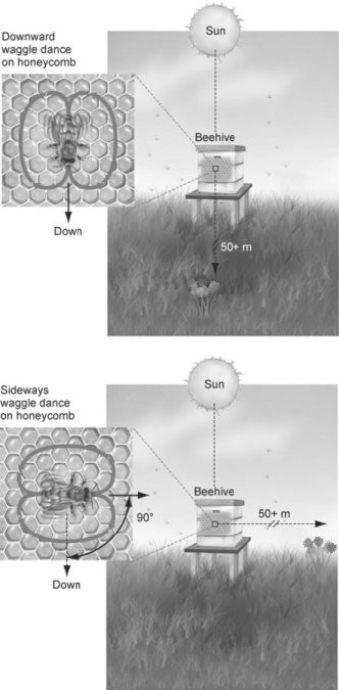 From the figure, what can we determine about the location of the food source?
From the figure, what can we determine about the location of the food source?
A) The waggle dance in the top figure indicates that the food is directly under the hive.
B) The waggle dance in the bottom figure indicates that the food is to the west of the hive.
C) The waggle dance in the top figure indicates that the food is close to the hive.
D) The waggle dance in the bottom figure indicates that the food is 90° to the right of the sun.
Correct Answer

verified
Correct Answer
verified
Multiple Choice
Use the following figure to answer the question.
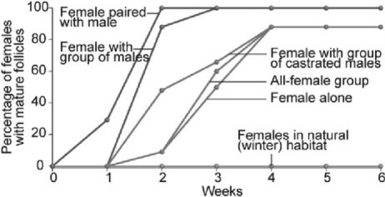 Based only on the information in the figure, which of the following conclusions is most logical?
Based only on the information in the figure, which of the following conclusions is most logical?
A) Females produce more eggs more quickly when exposed to breeding males.
B) Females produce eggs more quickly when exposed to many males than females paired with a male.
C) All non-isolated females do just as well as isolated females.
D) After four weeks together, females with males produce mature follicles to the same extent as females without males.
Correct Answer

verified
Correct Answer
verified
Multiple Choice
Scientists believe that the direction birds go when migrating is guided in part by ________. I.the stars in the night sky II.the sun during the day III.the magnetic field of the Earth
A) only I
B) only II
C) only III
D) I, II, and III
Correct Answer

verified
Correct Answer
verified
Multiple Choice
Which of the following best describes "game theory" as it applies to animal behavior?
A) The fitness of a particular behavior is influenced by other behavioral phenotypes in a population.
B) The total of all of the behavioral displays, both male and female, is related to courtship.
C) The play behavior performed by juveniles allows them to perfect adult behaviors that are needed for survival, such as hunting, courtship, and so on.
D) The evolutionary "game" is played between predator and prey. A behavior evolves in the prey in response to the nature of the predatory behavior.
Correct Answer

verified
Correct Answer
verified
Multiple Choice
Listed are several examples of types of animal behavior. Choose the letter of the correct term (A-E) that matches each example in the following questions. A. operant conditioning B. classical conditioning C. innate behavior D. imprinting E. altruistic behavior -Through trial and error, a rat learns to run a maze without mistakes to receive a food reward.
A) A
B) B
C) C
D) D
Correct Answer

verified
Correct Answer
verified
Multiple Choice
Which of the following examples describes a behavioral pattern that results from a proximate cause?
A) A cat kills a mouse to obtain nutrition.
B) A male sheep fights with another male because it helps to improve its social position.
C) A female bird lays its eggs because the amount of daylight is decreasing slightly each day.
D) A goose squats and freezes motionless to escape a predator.
Correct Answer

verified
Correct Answer
verified
Multiple Choice
A region of the canary forebrain shrinks during the nonbreeding season and enlarges when breeding season begins. This change is probably associated with the annual ________.
A) addition of new syllables to a canary's song repertoire
B) crystallization of subsong into adult songs
C) renewal of mating and nest-building behaviors
D) elimination of the memorized template for songs sung the previous year
Correct Answer

verified
Correct Answer
verified
Multiple Choice
Which of the following examples reflects the concept of optimal foraging?
A) During foraging, a mule deer will consume food as soon as it finds it, regardless of the location.
B) A cheetah will continue a chase for prey, regardless of how long the chase lasts or how much energy is consumed.
C) A moose spends more time looking for food when the food is high quality than when the food is low quality.
D) If an animal is hungry it will consume food as soon as it is found, regardless of the food quality or the risk.
Correct Answer

verified
Correct Answer
verified
Multiple Choice
Pair-bonding in a population of prairie voles can be prevented by ________.
A) the ensuing confusion caused by introducing meadow voles
B) administering a drug that inhibits the brain receptor for vasopressin in the central nervous system (CNS) of males
C) dying the coat color from brown to blond in either male or female prairie voles
D) allowing the population size to reach critically low levels
Correct Answer

verified
Correct Answer
verified
Multiple Choice
The fru gene in fruit flies ________. I.is a master regulatory gene that directs expression of many other genes II.can be genetically manipulated in females so that they will perform male sex behaviors III.programs males for appropriate courtship behaviors
A) only I and II
B) only I and III
C) only III
D) I, II, III
Correct Answer

verified
Correct Answer
verified
Multiple Choice
White-crowned sparrows can only learn the "crystallized" song for their species by ________.
A) listening to adult sparrow songs during a sensitive period as a fledgling, followed by a practice period until the juvenile matches its melody to its memorized fledgling song
B) listening to the song of its own species during a critical period so that it will imprint to its own species song and not the songs of other songbird species
C) performing the crystallized song as adults when they become sexually mature, as the song is programmed into the innate behavior for the species
D) observing and practicing after receiving social confirmation from other adults at a critical period during their first episode of courtship behavior
Correct Answer

verified
Correct Answer
verified
Multiple Choice
Which of the following is true of innate behaviors? Innate behaviors ________.
A) are only weakly influenced by genes
B) occur in invertebrates and some vertebrates but not mammals
C) are limited to invertebrate animals
D) are expressed in most individuals in a population
Correct Answer

verified
Correct Answer
verified
Multiple Choice
Use the following figure to answer the question.
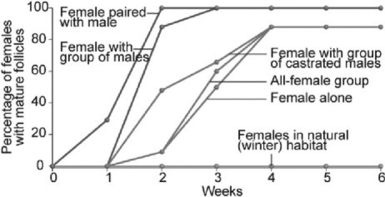 Based on the information in the figure, which of the following would you expect to observe in these animals?
I.sexual dimorphism
II.polygamy
III.agonistic behavior
Based on the information in the figure, which of the following would you expect to observe in these animals?
I.sexual dimorphism
II.polygamy
III.agonistic behavior
A) only II
B) I and II
C) I and III
D) I, II, and III
Correct Answer

verified
Correct Answer
verified
Multiple Choice
A region of the canary forebrain shrinks during the nonbreeding season and enlarges when breeding season begins. This change is probably associated with the annual
A) addition of new syllables to a canary's song repertoire.
B) crystallization of subsong into adult songs.
C) sensitive period in which canary parents imprint on new offspring.
D) elimination of the memorized template for songs sung the previous year.
Correct Answer

verified
Correct Answer
verified
Multiple Choice
According to Hamilton's rule,
A) natural selection does not favor altruistic behavior that causes the death of the altruist.
B) natural selection favors altruistic acts when the resulting benefit to the recipient, corrected for relatedness, exceeds the cost to the altruist.
C) natural selection is more likely to favor altruistic behavior that benefits an offspring than altruistic behavior that benefits a sibling.
D) the effects of kin selection are larger than the effects of direct natural selection on individuals.
Correct Answer

verified
Correct Answer
verified
Showing 41 - 60 of 69
Related Exams